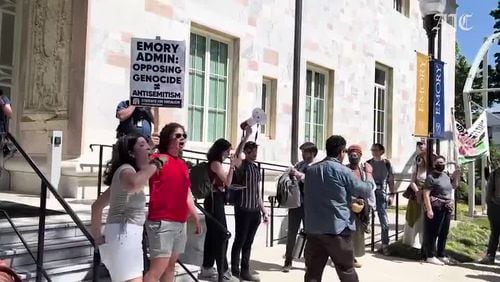EXHIBIT PREVIEW
“Gatheround: Stories of Atlanta”
Opens July 2; 10 a.m.-5:30 p.m. Mondays-Saturdays; noon-5:30 p.m. Sundays. $16.50 adults; $13 seniors, students; $11 youths; free for members, children under 4; free admission for everyone on July 2. 130 W. Paces Ferry Road N.W, Atlanta. 404-814-4000, www.atlantahistorycenter.com.
History is not taxidermy, but for 20 years, the Atlanta exhibit at the Atlanta History Center stayed more or less motionless on its perch.
This year, the Atlanta exhibit was shut down, stripped to the studs, and re-created. The new version opens July 2, with a philosophy that the display, like the city, should breathe and grow.
Far from inert, the exhibit, called “Gatheround: Stories of Atlanta,” is equal parts theater, artifact and tall tale. Visitors will be embedded in three-dimensional re-creations of Atlanta environments — a barbershop, a restaurant, a “washing society” — and hear costumed performers relive chapters of the city’s ages.
While there are several major permanent exhibits at the History Center about many aspects of Georgia, including “Turning Point: The American Civil War” and “Shaping Traditions: Folk Arts in a Changing South,” the Atlanta exhibit is the cornerstone of the center, an experience that attempts to explain the city from its roots to its flowers.
The spoken word is king here. Scattered around the 7,700-square-foot exhibit are parabolic "domes" telling stories. Some of these are recordings of actors delivering lines once spoken by others — Henry Grady's "New South" speech for example. Others are recordings of individuals who made history themselves: You can hear restaurateur and Serenbe co-founder Marie Nygren talk about her mother, Margaret Lupo, who turned Mary Mac's tea room into an Atlanta institution, or hear an interview with a survivor of the great fire of 1917.
Atlanta History Center historian and exhibit curator Calinda Lee said there are perhaps 5.5 hours of recordings to hear, if you scour every corner of the exhibit. Even the name of the exhibit, “Gatheround,” sounds like an invitation from a storyteller. Come, sit by the fire and listen to this.
“That’s exactly what it’s meant to be,” Lee said. “So, good! It worked!”
The new exhibit comes at a heady time. Things are popping at the Atlanta History Center. Under the guidance of new President and CEO Sheffield Hale, the center has turned itself from quiet to bustling.
Formerly tucked away from traffic, the center now boasts a new entry and atrium that communicate directly with West Paces Ferry Road. Inside that atrium is a flow of activity, moving from the new two-story Souper Jenny restaurant and bookstore at one side to the exhibits at the other.
Nearby girders rise for a purpose-built structure to house the restored Cyclorama painting of the Battle of Atlanta, which will move from Grant Park to the History Center sometime in the next six to nine months. As the Civil War locomotive the Texas is refurbished, to eventually be displayed lit up at night in its own gargantuan glass cabinet, like a birthday cake in a bakery case, a sense of expanding possibilities imbues the Buckhead institution.
“Gatheround” extends that dynamic feel by incorporating visitors into the story. There are two recording studios at the center of the exhibit, quiet booths where visitors can contribute three minutes’ worth of their own memories. Those taped reminiscences will be archived, and might be included in the exhibit.
“This is not going to be a mini-Ken Burns movie,” Lee said of the introductory video, “but a narrative where contemporary Atlanta reflects on the importance of this city’s history in getting us to this place.”
As dynamic as the exhibit is Lee herself. A 4-foot-11-inch power plant, one can imagine sparks flying out of the gold-tinted tips of her curly hair. She studied at Spelman and Emory and has worked at museums in Washington, D.C., Chicago and Albuquerque, N.M. She was born in Baltimore, and says, “I grew up in six cities on two continents.”
Eleven days from opening day, the exhibit swarmed with workers and clanged with grinders, circular saws and pneumatic drills. A small percent of the displays were complete, and as Lee watched, a young man lifted what looked like a scooped-out rock onto a small pedestal.
“That’s the oldest object in here,” she said. The rock is a soapstone bowl, carved by Woodland period Native Americans, who lived in Georgia for 2,000 years or so, until 900 A.D.
Because the History Center has a full exhibit devoted to Native Americans (“Native Lands: Indians and Georgia”), the Atlanta exhibit doesn’t dwell on examining the first residents of the area. On the other hand, said Lee, they deserve a spot in the story, since “we built on the footprint of Standing Peachtree,” the Creek Indian village that established this confluence of rivers as a center for commerce and transportation.
The exhibit is organized into four themes: family and community; politics and justice; cultural life; and urban growth. It checks in with the big names that resonate in Atlanta history — the Rev. Martin Luther King Jr., Henry Grady, Coca-Cola — but many times the story is told by unknowns. Some of those unknowns are children.
Lee has purposely picked out chapters in the story of Atlanta that feature young people, because so many of her visitors are young. They can learn about child labor in the woeful textile industry, which regularly employed nimble little fingers to thread bobbins; they can hear the oral history of Lina McFarland, who worked at the Fulton Bag and Cotton Mill from the time she was 11 years old.
The exhibit shows how battles over integration often placed children on the front lines. A photo of Rosalyn Walton, one of the first black students to attend Murphy High School — now Crim High School — tells this story in a heartbreaking way. She and her principal sit in an empty typing class. No other students are visible.
“It was,” said Lee, “a lonely story.”
About the Author






